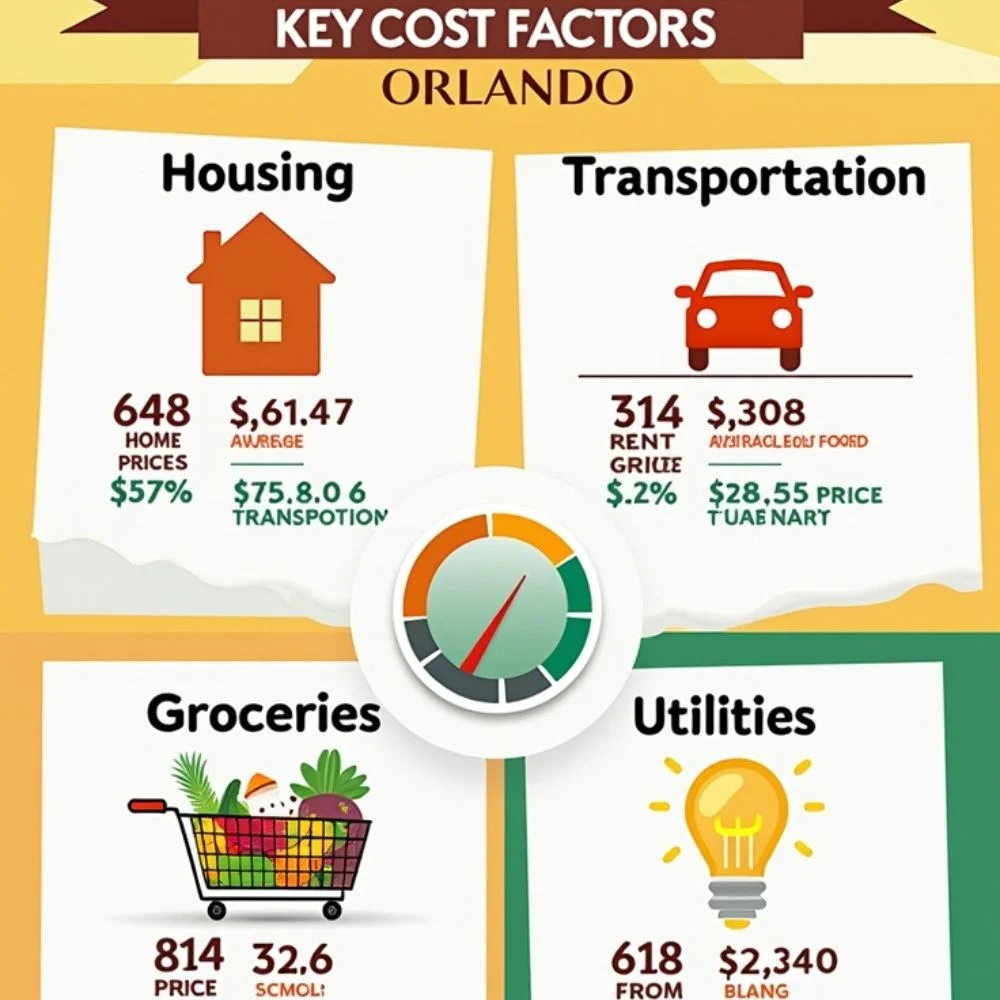Table of Contents
- Orlando’s Economic Evolution
- What Is the Median Income in Orlando in 2025?
- Orlando’s Income Growth
- Income Trends by Orlando Neighborhood
- Orlando’s Cost of Living in 2025
- Who’s Benefiting Most from Income Growth?
- The Downsides: Economic Gaps
- Practical Tips for Orlando’s Income
- What’s Next for Orlando?
- Conclusion
Orlando’s Economic Evolution
Orlando isn’t just famous for its world-class theme parks and sunshine, it’s also becoming one of the fastest-growing metro areas in Florida. With population booms, business development and an ever-evolving job market, understanding Orlando’s income landscape is more important than ever whether you’re a resident, a potential mover or a savvy investor.
The latest income statistics, growth facts, cost of living implications and how these numbers affect real people and businesses in the City.
What Is the Median Income in Orlando in 2025?
1. The Latest Numbers
As of 2025, the median household income in Orlando is estimated to be $65,200, according to projections based on data from the U.S. Census Bureau and regional economic forecasts. The median income has climbed from $58,000 in 2020 to $65,200 in 2025, showing a strong 12.4% growth over just five years.
For comparison:
- State of Florida Median Income (2025): $68,000
- U.S. National Median Income (2025): $72,000
While Orlando still trails the national average, it’s closing the gap and fast.
2. What’s Driving Orlando’s Income Boom?
Several factors have contributed to this income rise:
- Tech and healthcare expansion: Orlando’s innovation hubs and medical centers are attracting high-paying roles.
- Tourism rebound: Post-pandemic tourism surged back, boosting related sectors like hospitality, retail, and services.
- Population growth: New residents often bring skilled labor and demand for better-paying jobs.
Orlando’s Income Growth
1. Comparing Past to Present
In 2015, Orlando’s median income was just $48,400. Compare that to 2025’s $65,200 and you’re looking at a 34.7% increase in a decade. That’s a solid upward trend especially when you factor in the city’s relatively young workforce and job market diversity.
2. Which Jobs Are Driving Income Growth?
Orlando’s income spike isn’t random. It’s tied directly to growth in key industries:
- Healthcare & biotech: Average salary: $85,000+
- Engineering & construction: Fueled by infrastructure projects and new developments.
- Technology & digital services: Remote work and tech startups are booming.
- Education & research: Anchored by institutions like UCF and Valencia College.
Even traditionally lower-paying sectors like hospitality have seen wage improvements thanks to labor shortages and increased demand.
Income Trends by Orlando Neighborhood
1. Where Are Incomes the Highest?
Some Orlando neighborhoods are leading the way in income growth:
- Lake Nona: A planned community with a heavy emphasis on medical and tech industries. Median income: ~$105,000
- Baldwin Park: Trendy and affluent. Median income: ~$95,000
- Winter Park: Historic charm meets economic strength. Median income: ~$90,000
2. More Affordable Areas
Neighborhoods with below-average income levels but rising:
- Pine Hills: ~$45,000
- Azalea Park: ~$48,500
- Paramore/West Downtown: ~$43,000
These areas are seeing slow but steady increases as redevelopment and gentrification bring in new opportunities.
Orlando’s Cost of Living in 2025
Key Cost Factors

- Housing: The median home price in Orlando in 2025 is about $365,000, up 9% from 2024. Rent for a 2-bedroom apartment averages $1,800/month.
- Transportation: Public transport has expanded, but car ownership remains the norm—adding $600–$800/month in expenses.
- Groceries & utilities: Slightly above the national average, largely due to high tourism demand and supply chain fluctuations.
Cost vs. Income
While income growth is promising, inflation and cost of living are climbing too. For many families, the balance is still tight. A dual-income household now needs to earn about $80,000+ annually to live comfortably in many parts of Orlando.
Who’s Benefiting Most from Income Growth?
1. Young Professionals and Remote Workers
Orlando is increasingly attractive for young workers and remote employees relocating from higher-cost states like California and New York. Their higher expected salaries shift the income averages upward and inject new spending into the local economy.
2. Long-Term Residents
Many longtime residents are finally seeing wages increase after years of stagnation especially in sectors like education, law enforcement and skilled trades.
3. Business Owners
Entrepreneurs and small business owners are also enjoying the uptick in disposable income, as it translates to more local spending on goods, services, and entertainment.
The Downsides: Economic Gaps
Despite growth, not everyone is feeling the benefits equally. Economic inequality still lingers.
Wage Disparities
- Gender pay gap: Women in Orlando still earn about 87 cents for every dollar a man earns.
- Racial income gap: Black and Hispanic households often earn 15–25% less than white households, reflecting persistent structural challenges.
Affordable Housing Shortages
Renters are feeling the squeeze as housing prices rise more quickly than household incomes. Waitlists for affordable units are long, and eviction rates are slowly rising.
Practical Tips for Orlando’s Income
Whether you’re moving to Orlando, planning a career change or simply curious about your earning potential, here are some real-world suggestions:
1. Consider Fast-Growing Sectors
Want a piece of the income boom? Target roles in:
- IT and software
- Advanced manufacturing
- Healthcare (especially nursing and tech roles)
- Skilled trades (plumbing, electrical, HVAC)
2. Leverage Local Resources
CareerSource Central Florida actively provides free resources like job training, resume support, and employment placement to help residents advance their careers.
3. Think Long-Term Housing
If you can buy instead of rent, it might be worth the upfront investment. With real estate appreciating steadily, homeownership can be a strategic financial move in Orlando.
4. Network Locally
Orlando’s coworking spaces, community meetups and university extension programs are great for connecting with peers and employers.
What’s Next for Orlando?
1. More Jobs, More Growth
The city is planning to add over 150,000 new jobs by 2030, focusing heavily on STEM, construction and healthcare. Brightline expansion and downtown redevelopment projects are actively driving new economic growth throughout the city.
2. Innovation and Tech Will Lead
Expect startups and remote-friendly companies to continue shaping the job market and boosting income levels with them.
3. Watch for Policy Changes
The city and state are investing in workforce development, education, and housing affordability, all of which will directly impact future income levels.
Conclusion
Orlando’s median income in 2025 tells a powerful story of transformation. In just a few years, the city has gone from a tourism-heavy, middle-income metro to a more diversified, opportunity-rich hub. While challenges like income inequality and rising living costs remain, the overall trend is clear, Orlando is on the rise.








